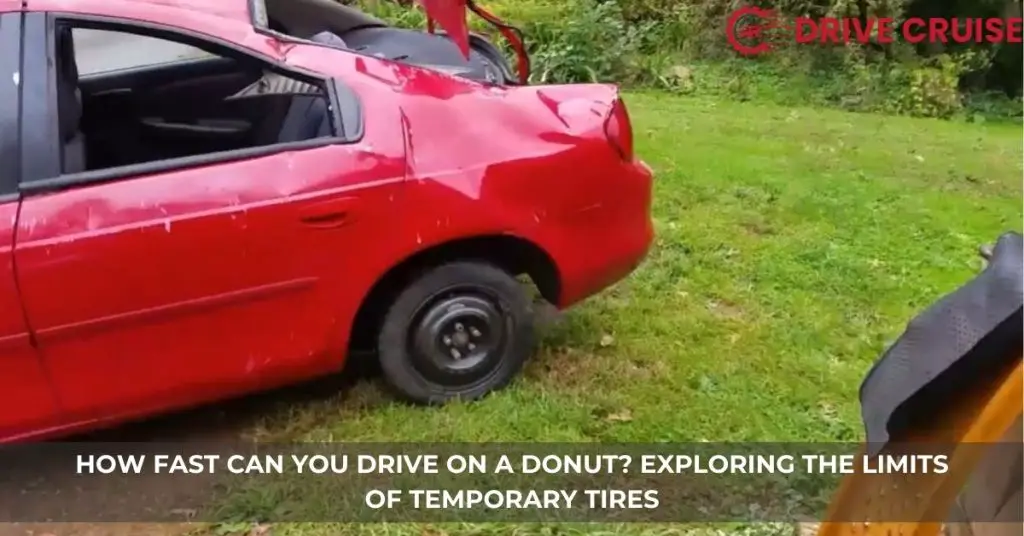We’ve all been there—cruising down the highway when suddenly, a tire goes flat. After pulling over and swapping it out for that compact spare, commonly known as a donut, we’re back on the road. But then the question hits us: How fast can we actually drive on this thing? It’s a common scenario that sparks a blend of caution and curiosity.
Navigating the road on a donut isn’t quite the same as driving on a full-sized tire. There are limits, and for good reason. We’re here to shed some light on this topic, guiding you through the dos and don’ts of driving on a spare tire. Understanding these can make all the difference in keeping you safe while you’re on your way to getting that tire replaced. So, let’s dive in and explore just how fast you can go without risking your safety or damaging your vehicle.
Understanding Donut Spare Tires
Moving from the general scenarios of driving on a compact spare tire, or a donut, we find it’s pivotal to grasp the essentials of these unique automotive components. Donut spare tires are not designed for long-term use, unlike their full-sized counterparts. Typically, they’re significantly smaller, lighter, and made with a different internal structure, aimed to save space and weight in a vehicle for emergency purposes.
One of the first things to note is that donut spares have a limited lifespan. Manufacturers recommend using them for distances not exceeding 50 to 70 miles. This limitation stems from their reduced durability and decreased tread depth, which significantly impacts their lifespan when compared to regular tires.
Moreover, the size difference affects the vehicle’s handling. With a donut spare, cars may experience reduced stability, particularly at higher speeds, and during sharp turns or abrupt stops. This is due to the spare’s smaller contact patch with the road, leading to less grip.
Speed also plays a crucial role when driving on a donut spare tire. A general guideline is to not exceed speeds of 50 miles per hour. This restriction aims to safeguard the driver by minimizing the risk of tire failure due to the increased stress on the smaller, less robust spare tire.
Lastly, awareness of tire pressure is essential. Donut spares usually require a higher inflation pressure than standard tires, often around 60 psi, to compensate for their smaller size. Regularly checking the tire’s pressure ensures optimal performance and safety.
By understanding these aspects of donut spare tires, drivers can make informed decisions, ensuring they navigate the roads safely until they can replace the spare with a standard tire.
Limitations of Driving on a Donut
Building on what we’ve discussed about the necessity of adhering to the right speed limit while using a donut spare, it’s crucial to delve deeper into the limitations that accompany driving on this compact tire.
Firstly, handling and control take a significant hit with a donut spare. Due to its smaller size and different construction compared to standard tires, vehicles might experience less stability, especially when making sharp turns or during sudden stops. This reduced stability can affect the ease of maneuvering the vehicle, making it vital to drive cautiously.
Secondly, the braking distance can also increase. The disparity in tire sizes can lead to uneven braking power distribution among the four tires. In emergencies, this imbalance might result in longer stopping distances, posing a risk to safety.
In addition, it’s essential to be mindful of the impact on the vehicle’s differential. Continuous driving on a donut, especially over the recommended distance or speed, can strain the differential since it has to compensate for the difference in tire size. This strain can lead to premature wear or damage, potentially incurring significant repair costs.
Moreover, driving on a donut spare for extended periods does not only risk wear and damage to the vehicle’s components but also jeopardizes fuel efficiency. The increased resistance and imbalance can lead to higher fuel consumption, making the vehicle less economical to drive.
Lastly, the traction and performance on wet or slick surfaces can diminish. The donut’s design does not provide the same level of grip and water displacement as regular tires, which might increase the risk of hydroplaning or losing control in adverse weather conditions.
Understanding these limitations allows us to appreciate the importance of using a donut spare tire as a temporary solution. It’s imperative to replace the donut with a standard tire at the earliest opportunity, ensuring our safety and the vehicle’s optimal performance.
Safety Tips for Driving on a Donut
After recognizing the limitations and specific care requirements while driving on a donut spare, it’s critical to adhere to essential safety tips to minimize risks. These guidelines are not just about keeping within the speed limit of 50 miles per hour but also involve a broader approach to ensure both your safety and the vehicle’s integrity during this temporary period.
- Inspect the Donut Before Use: Before installation, we check the donut spare for any signs of wear or damage and ensure it’s inflated to the recommended 60 psi. An underinflated or damaged spare can critically affect the vehicle’s handling and safety.
- Limit Your Distance: We adhere to the advised maximum distance of 50 to 70 miles on a donut to prevent prolonged strain on the vehicle. It’s a reminder that the donut is a temporary fix, nudging us to seek a permanent tire replacement promptly.
- Avoid Highways and High-Speed Roads: If feasible, we take alternative routes to avoid highways. Lower speeds on local roads not only keep us within the donut’s speed limitation but also reduce the risk of accidents due to decreased vehicle stability.
- Drive Smoothly: Abrupt turns, hard braking, and rapid accelerations can put undue stress on the donut spare. We advocate for smooth, cautious driving maneuvers to maintain control and minimize wear on the spare tire.
- Regularly Check Tire Pressure: Even short-term use requires that we monitor the donut’s air pressure closely, ensuring it remains at the optimal level for safety and performance.
- Schedule a Tire Replacement or Repair Immediately: Last but certainly not least, we prioritize scheduling an appointment to replace the donut with a standard tire or repair the original flat tire as soon as possible, reinforcing our commitment to safety and vehicle care.
By following these safety tips, we not only protect ourselves but also extend the life of the donut spare, ensuring it serves its purpose without compromising the vehicle’s overall performance and safety.
How Fast Can You Drive on a Donut?
Given the compact nature and design of a donut spare tire, it’s crucial to understand how speed affects its performance and the overall safety of your vehicle. Typically, the advised maximum speed limit while driving on a donut is 50 miles per hour. This recommendation stems from the tire’s limited durability and the need to prevent excessive wear or potential damage.
Donut spares are significantly smaller than standard tires, contributing to a decrease in stability and handling. When driving over 50mph, these limitations become more pronounced, increasing the risk of accidents, especially on highways or in conditions that require rapid maneuvers. Additionally, the disparity in tire size can strain the vehicle’s differential because of the uneven tire rotation speeds. Maintaining speeds at or below 50mph minimizes this strain, ensuring the vehicle remains manageable and responsive.
Here are key practices to keep in mind when driving on a donut:
- Monitor Speed Rigorously: Ensure you’re constantly aware of your speed, keeping it under the 50mph threshold.
- Avoid High-Speed Roads: Whenever possible, select routes that enable you to drive at lower speeds, avoiding highways or interstates.
- Drive Smoothly: Abrupt acceleration, hard braking, or sharp turns can place added stress on the donut. Aim for smooth transitions in all driving actions.
- Regularly Check Tire Pressure: Keeping the donut inflated to the recommended psi is vital for its performance and your safety. The recommended pressure is usually around 60 psi.
By adhering to these guidelines, you can safely navigate your vehicle to its next service appointment without exacerbating the situation. Remember, a donut spare is a temporary solution designed to get you to a professional who can provide a permanent fix. Driving cautiously not only maximizes the life of the spare but also ensures your safety and that of other road users.
Replacing Your Donut Spare
After stressing the importance of driving cautiously on a donut spare and understanding its limitations, it’s crucial to discuss the next critical step: replacing your donut spare with a full-sized tire. The transition from using a temporary spare tire to installing a permanent one ensures your vehicle returns to optimal safety and performance levels.
First, recognize the urgency in replacing your donut spare. Despite being a reliable temporary solution, a donut spare isn’t intended for long distances or prolonged use. Manufacturers typically recommend replacing the donut spare within 50 to 70 miles, ensuring you don’t push the limit of the spare tire’s capabilities.
Second, locating a suitable replacement tire involves checking your vehicle’s manual or the sidewall of your other tires for the correct size and specifications. Matching the new tire with the existing ones on your vehicle preserves handling and stability, ensuring a smoother and safer ride.
Third, visiting a reputable tire shop or dealership for tire replacement is our recommendation. Professionals there can advise on the best tire options for your vehicle, considering factors like tread pattern and tire quality, to match your driving needs.
Lastly, don’t forget to assess the condition of your spare tire compartment and tools after the replacement. Ensuring your jack, lug wrench, and any other necessary equipment are in good condition and correctly stored allows you to be prepared for any future tire emergencies.
By following these steps, we ensure our safety on the road and maintain the condition and value of our vehicle. Always prioritize replacing your donut spare with a full-sized tire promptly to avoid any further complications and to continue driving with confidence.
Conclusion
We’ve covered the essentials of navigating the roads safely on a donut spare tire. It’s clear that keeping speeds at or below 50 mph and maintaining a vigilant eye on tire pressure are key to ensuring your safety and the integrity of your vehicle. Remember, these compact spares are a temporary fix. They’re not designed for long distances or high speeds. Their limitations, from handling to fuel efficiency, underscore the urgency of replacing them with a full-sized tire as soon as possible. Let’s make sure we’re all driving smoothly and cautiously, especially when we’re on a donut. And don’t forget, getting that permanent tire replacement within 50 to 70 miles isn’t just a recommendation—it’s a necessity for keeping us safe on the road. Let’s stay informed, prepared, and above all, safe, no matter where our journeys take us.
Related Posts:
- Kumho Tires vs Michelin: Which One Should You Choose?
- Bridgestone Dueler LTH vs Michelin Defender LTX M/S: Which is the Better Tire?
- How Fast Can You Drive on a Donut? Exploring the Limits of Temporary Tires
- How Long Does Driving School Take? A Guide to Understanding the Time Commitment
- Which Cooper Tires Are Made in the USA: A Guide to Finding American-Made Tires







